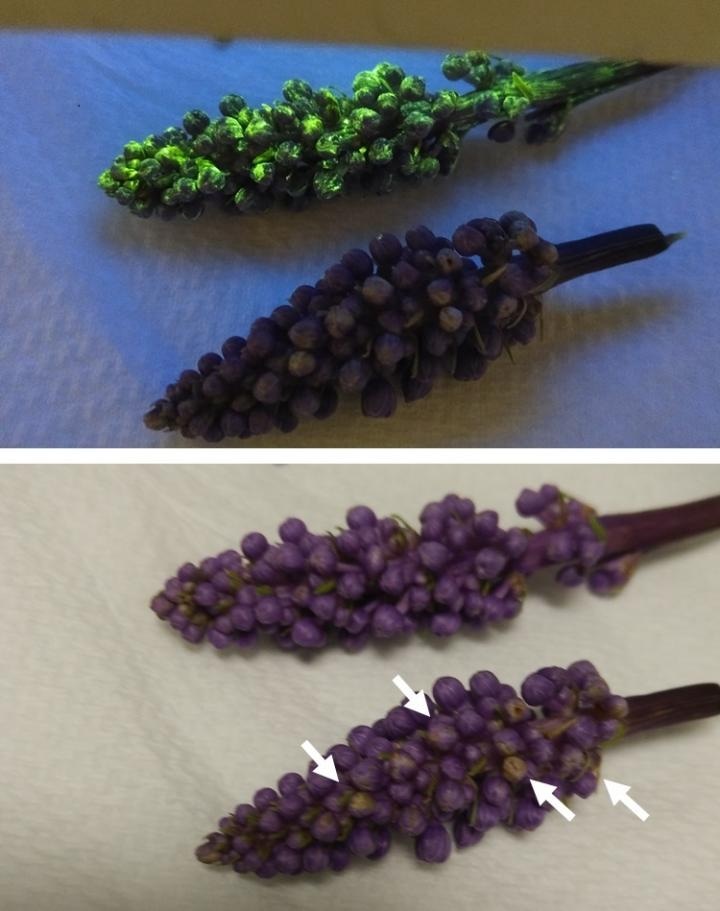Apr 4 2019
Human-machine hybrids with extraordinary powers have long been visualized by science-fiction writers. However, “super plants” with incorporated nanomaterials may be much closer to being real when compared to cyborgs.
 An external nanomaterial coating (luminescent green; top image) protects a lilyturf plant cutting from harsh UV rays (bottom image), which wilt and discolor the unprotected plant (arrows). (Image credit: Joseph Richardson)
An external nanomaterial coating (luminescent green; top image) protects a lilyturf plant cutting from harsh UV rays (bottom image), which wilt and discolor the unprotected plant (arrows). (Image credit: Joseph Richardson)
Now, researchers describe the development of plants that can produce nanomaterials known as metal-organic frameworks (MOFs) and the application of MOFs as coatings on plants. The improved plants could potentially carry out useful new functions, such as detecting chemicals or tapping light more efficiently.
The scientists will present their outcomes at the American Chemical Society (ACS) Spring 2019 National Meeting & Exposition, on April 3rd, 2019. ACS, the largest scientific society in the world, is conducting the meeting until Thursday, April 4th, featuring almost 13,000 presentations on a broad spectrum of science topics.
The lead researcher of the project, Joseph Richardson, PhD, reports that for thousands of years, humans have been introducing foreign materials to plants.
One example of this is flower dyeing. You’d immerse a cut flower stem into some dye, and the dye would be taken up through the stem and penetrate into the flower petals, and then you’d see these beautiful colors.
Joseph Richardson, PhD, Project Lead Researcher, University of Melbourne
The wide vascular networks of plants enable them to easily absorb water and molecules dissolved in fluids. However, it is harder for bigger materials and nanoparticles like MOFs to pass through roots. Thus, Richardson and colleagues at the University of Melbourne (Australia) suspected if they could feed MOF precursors to plants, which would be absorbed by them and subsequently turned into finished nanomaterials.
MOFs––which contain clusters or metal ions linked to organic molecules––produce highly porous crystals that can absorb, store, and release other molecules, almost similar to a sponge. Until now, chemists have produced thousands of different MOFs with promising applications ranging from storing hydrogen fuel through absorbing greenhouse gases to dispensing medications within the body. Rendering plants to produce small amounts of these useful compounds in their own tissues could provide them new unnatural potentials.
To check if plants could produce MOFs, Richardson and colleagues combined metal salts and organic linkers to water and then kept intact plants or cuttings into the solution. The plants carried the precursors into their tissues, where two different types of fluorescent MOF crystals grew.
In a proof-of-concept experiment, MOF-producing lotus plant clippings identified small concentrations of acetone in water, as indicated by a decrease in fluorescence of the materials. Depending on these outcomes, Richardson aims to study whether plant-MOF hybrids could detect explosives or other volatile chemicals, which could be helpful for airport security.
The finished materials not only make the plants to produce MOFs but could also be used as a coating on the plants to help them turn harmful ultraviolet (UV) rays into light that is more useful for photosynthesis.
As we contemplate growing crops in space or on Mars where you don’t have an atmosphere and are bombarded by UV rays, something like this could be helpful. That’s because it not only protects the plants from the UV rays, but it also turns them into useful energy. Especially as you get farther away from the sun, it’s harder to capture all of the light you’d need for photosynthesis.
Joseph Richardson, PhD, Project Lead Researcher, University of Melbourne
The investigators have already begun exploring the protective capabilities of the nanomaterials, and the preliminary data show potential. The group coated clippings of lilyturf and chrysanthemum with luminescent MOFs and after that, the plants were exposed to UVC light for three hours. The plants with MOFs exhibited less wilting and bleaching when compared to uncoated clippings.
Currently, Richardson is partnering with plant biologists to investigate the effects of MOFs on plant growth. Until now, they have not observed any toxicity of the nanomaterials. Additionally, scientists wish to determine whether MOFs could actually help plants grow better, which may result in applications in agriculture.
The scientists acknowledge support and funding from the Japan Society for the Promotion of Science and the Australian Research Council Centre of Excellence in Convergent Bio-Nano Science and Technology.
New Plants and MOFs - Headline Science
Video credit: ACS